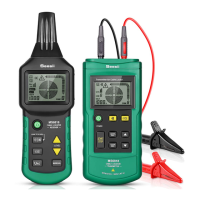Operating instructions for Cable Detector, article 37270766
Page 18 of 34
1. Make sure of complete grounding.
2. The transition resistance of a line break must be higher than 100 kOhm.
3. The grounding connected to the transmitter can the ground of a socket or a properly grounded water
pipe.
4. When finding breaks in multi-strand cables, make sure that all the other wires in the shielded cable or
lead are properly grounded. This is necessary to avoid cross-coupling of the signals fed in (through
capacitive effect on the output connections). The tracking depth for shielded cables and leads differs,
since the individual wires in the shielded cable are twisted around each other.
5.1.5 Fault detection in defective electric underfloor heating
Requirements:
The circuit must not be live.
All unused leads must be connected to auxiliary ground as shown in Fig. 3.1.5a.
Connect both transmitters (if two will be used) as shown in Fig. 3-1-5b.
Proceed as in the example application.
1. If a shielding mat is laid on heating wires, there must
be no ground connection. If necessary remove the
shielding from the ground connection.
2. Ensure that there is complete grounding and enough
distance between the ground connection of the
transmitter and the line being searched for. If the
distance is too small, the signal and the line cannot
be precisely located.

